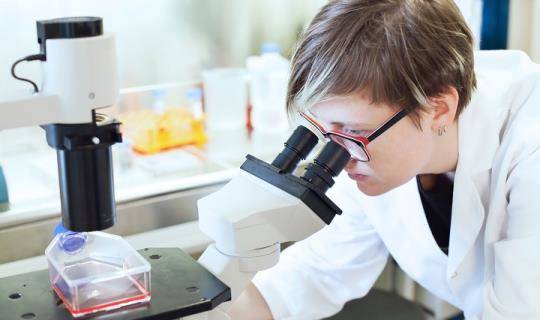Podcast: What are the keys to creating sustainable pharmaceutical supply chain operations?
By World Courier
Transcript
Mike Iorfino: Welcome to the World Courier insights podcast. I'm Mike Iorfino, Manager of External Communications at AmerisourceBergen, and your host for this podcast, where we cover the latest news and priorities across the pharmaceutical industry. Today, our conversation will focus on strategies to build more sustainable and efficient operations across the supply chain.
I'm thrilled to be joined by two experts - Paula Pulsoni, Senior Director of Clinical Supply Solutions at World Courier, and Giulia Ferrati Director of Corporate Responsibility and Sustainability at AmerisourceBergen.
Giulia, there are a number of different topics I want to cover today, but let's start here. Can you explain the role of the corporate responsibility and sustainability team?
Giulia Feira: Thank you, Mike and such a pleasure to be here. As you mentioned, I'm part of the corporate responsibility and sustainability team, which means that I engage different businesses and different departments to drive programs and practices to create a positive impact on people and planet. As an organization, we have a responsibility to leverage our position and value in the industry to drive this positive change. We see this work really tied up to our purpose.
We know that creating healthier futures starts with protecting the health of the people and the planet. Historically and traditionally, the corporate responsibility and sustainability work within an organization was a ‘nice to have’, but in the current environment, it is a ‘must have’. We've got priorities like climate change or social issues that are coming up are becoming stronger and stronger, and our actions to mitigate them is becoming more and more important.
Mike: That's a really helpful overview and even helpful to hear how the role of these teams have evolved in recent years. Considering the size of AmerisourceBergen and knowing that World Courier has a presence in more than 50 countries, what factors go into building a global sustainability strategy?
Giulia: Yes, that's a great question, Mike. A strategy is built around the topics that the company can have an impact on specifically. At AmerisourceBergen, we've got a strategy built around three priorities.
The first priority is the purpose-driven team members pillar. It is a pillar on our social impact and is the company commitment to fundamental human rights and the company commitment to foster a diverse and inclusive work environment where team members of all backgrounds are treated with fairness, dignity, and respect.
The second pillar is our environmental pillar. We call it resilient and sustainable operations and is our commitment to operating efficiently as well as responsibly across our global supply chain. Our programs around reductions of emissions, waste, product safety, and sustainable packaging, for example.
The third pillar is the healthy communities for all. So is our commitment and we hope to inspire equitable access to healthcare within the global communities. To do that we partner with not-for-profit organizations to advance the wellbeing of patient populations, both human and animal.
We operate through the AmerisourceBergen Foundation, and in the past financial year, for example, the AmerisourceBergen Foundation donated more than $7.7 million to over a hundred not-for-profit partners operating with missions of advancing health equity to drive programs and practices that create a positive impact on people and planet. As an organization, we have a responsibility to leverage our position and value in the industry to drive this positive change.
Mike: You mentioned some of these core pillars and priorities. Are there any specific objectives that we're targeting?
Giulia: Yes, we've got one specific objective and it is around our environmental strategy. In June, 2021, AmerisourceBergen committed to science-based targets. Science-based targets are a pathway for companies to reduce gas emissions. Targets are considered science-based if they are in line with the latest climate science deemed necessary to meet the goals of the Paris Agreement, to limit global warming to 1.5 degrees Celsius.
This is a very well-established way for companies to set an external target. These are multi-year processes, and we are hoping to have a validated science-based target by the end of 2022. In the meantime, obviously, we continue to drive a program to reduce our emissions and in the last financial year in FY-21, we've reduced our scope one and two emissions by 4.6%, compared to our baseline year, FY-19.
Mike: That's excellent and really exciting to hear some of the progress that we're making there. What are some of the main focus areas right now? What are some of the initiatives that we're taking to achieve these goals?
Giulia: There are several areas that we're working on and why climate change is actually presenting some risks for our business, we also see a significant opportunity to adapt and innovate our strategy to continue to deliver on our promise while protecting the planet. We believe that energy management is critical for our sustainability. Obviously continuing to reduce our emissions and deploying energy efficiency measures across all businesses, which basically drive a reduction in consumption as well as in emissions.
Another significant part of our strategy is actually looking at how to switch to renewable, purchasing renewable electricity, renewable energy, and this will definitely help us make some considerable progress towards our science-based targets.
By the end of the previous financial year, we purchased 20% of our global electricity from renewable sources. We've got another area that is very material for us, and it's transportations. In some of our markets, we own our fleet, so we are looking at reducing the emissions from our fleet conducting, for example, route optimization audits, and trying to maximize the efficiency as well as reducing the environmental impact.
We are also starting to look at alternative fuel options as well. We are not only looking at climate management, but we're also looking at the climate adaptations as well. Basically, assessing the physical risks of our top 100 locations where we may experience, for example, as I said, risk associated to hurricanes or extreme weather conditions. These inform basically our business strategy and continuity planning as well. We have programs holistically we're looking at how reducing our emissions overall.
Mike: That's fascinating. Thanks for sharing all of that. Just turning it over to Paula here. Paula, as someone who leads operations for World Courier's global depot network, I know you're constantly working with teams around the world to ensure we have the infrastructure and capabilities in regions around the globe to help companies advance pharmaceutical innovation and access. Can you share more about your role and how our focus on sustainability factors into that decision-making and our overarching vision?
Paula Pulsoni: Sure, Mike. I currently lead the depot network courier where we offer our warehousing and distribution solutions in 18 locations across the globe. We have direct contribution to what Giulia was reflecting on the corporate level. What is key for us is that we look at our sustainability vision as an opportunity, an opportunity to have a greater impact than ever on delivering healthy future is our purpose.
I like to think this is expanding our impact horizons where we deliver healthier futures by doing logistics with excellence as we have done for many years now, that have a true net positive impact but also taking care of the environment, of the ecosystem.
I think there is clear scientific evidence on how interlinked ecosystem wellbeing and health is. Also, general agreement on how accelerated we need to deliver on change. I think how fast we need to change our economic models to reduce negative consequences is our clear focus at the moment. For us, at World Courier, not only at the warehousing but also at the transport level, we see this as an opportunity to drive change, to make a better world, but also a responsibility to do it at a very accelerated pace. I was hearing Giulia talking about examples and objectives and I think most of the company focus right now is going around data, how data holds the key for us to make impactful decisions, have the highest impact results at the shortest timelines, so really investing a lot in exploring how to leverage that data, we hold and redesign our operational model with the right prioritization.
Mike: Yes – and just piggybacking off of that point there, in terms of how we're able to use data to inform our decision-making, for a global specialty logistics provider like World Courier, what steps are we taking or what steps can we take to reduce or lessen our environmental impact, while also ensuring people around the world continue to receive the critical medication that they need?
Paula: I think I can give you one example, a recent one. We have a proprietary packaging solution called Cocoon which is a reusable temperature control container shipper, which is a sustainable solution in itself, because it's reusable. More recently, World Courier teams of analysts have been using advanced network modelling to drive a smart decision-making on how to allocate the shippers around the globe, how to do it in the most efficient way.
Now, leaders at World Courier can make sure the Cocoon’s are whenever they are needed while reducing carbon footprint. This is tactically reduced by minimizing unnecessary reallocation of shippers with no payload. I think this is one of the most recent examples of how a sustainable solution through data continue evolving into a wider impact on sustainability.
Mike: That's a great example. I’d just be curious if there are any examples of how we're using data to inform decisions within our warehouses in addition to what you just shared about how we're using it to inform where and when our packaging solutions need to be placed around the world?
Paula: Yes, absolutely. As transport, warehousing is a big chapter on sustainability. I think I can mention we have recently completed an upgrade on our warehousing capacity model. Effectively, what we're trying to do here is better predicting occupancy. If we can better predict occupancy and evolve our warehouse designs to maximize capacity, in the end, what we're doing is extending the lifespan of our warehouses.
This is really key, really important because then we are extending the value of our assets for longer. In the end, it reduces the need for a new building. Construction, as you may know, is a high emission activity, so we are aiming to only go into construction when there is no more value to take out of our facilities, so really excited to see how our new designs are extending lifespan two, three, five years in our warehouses and how construction becomes a more let's say, rare occasion in some markets.
Mike: Now, shifting a little bit to waste management, which I know is a pressing topic, particularly within clinical trials. How is the industry and, more specifically, World Courier approaching this?
Paula: I think we collaborate with different levels of vendors from companies in the industry. It's very clear that minimizing waste, waste management is a common objective for the industry. I think we all share the obligation to design out waste. I think that's a very interesting concept, in which ways we need to start changing our mindset in which we see waste as a flaw in the process.
Our operational models need to evolve so that waste is not present as much as possible. You see this across the pharmaceutical industry, and more connected with the clinical trial industry across different levels. From our courier perspective, we started this journey long ago. Over 10 years ago, we completed the full global deployment of the infrastructure needed to switch entirely from single-use into reusable temperature control shippers.
Then we continue focusing on other elements that we were using in our operations like temperature monitors. We reduce temperature monitors' waste by developing a paper use model.
Historically, pools of monitor were allocated to clinical trials and you can share and they were single-use. There was lots of waste coming off expired, unused monitors. Then we deploy an operational model which we have a multiple-use pool that all clients can use from and then we contribute to very, very tangible reduction in waste. I think, from a different angle, we have also contributed through flexibilization of supply chain design tactics that have been used for many years now that industries like Just-In-Time or even hub distributions, including hubs in free trade zones are key. You don't need to be positioning pharmaceutical supplies in markets you don't need if you're going to use them, and gives a lot of flexibility to pharma companies and sponsors to plan better the use of their supplies and minimize waste.
I think the future is super exciting on that front, going back to the data component. I believe that through data analytics, we are seeing a lot of new opportunities to keep reducing waste, from real work evidence application into clinical trials, adaptive trials, and also artificial intelligence being used in more complex supply chain models. I really believe there is a whole new generation of supply chains we will be evolving within the industry in the coming years.
Mike: That's great. I think you hit on a couple of really important points there. I think, over the last couple of years, that flexibility and supply chain has been more important than ever before.
I want to close with this final question for both of you and it is more of a forward-looking question. Paula, you hit on it just now, but what do you both think is the key to more sustainable logistics operations? Giulia, I'll start with you.
Giulia: Yes, it's a great question. I think, as we look at the future, one of the key things that we should consider is partnership. I think, as an organization, we can do a lot, but we can only do so far, especially our business is the intersection between manufacturers or our upstream supply chain, and patients and collaboration is key. If we look for example, in terms of reducing emissions, the biggest chunk of emissions are normally coming from the supply chain and normally organization, as the footprint of the emission in the supply chain can be as high as 95%.
That collaboration with business partners and customers and our entire supply chain and as an industry towards a common goal, I think, is key to actually have more sustainable operations.
Paula: I agree. I think it's all about partnership. It's all about leveraging data together. This should be a common goal, a common goal for humans. A twist to that, that we are discussing internally more and more is how we see partnership. How do we define partnership. Automatically, when we say partnership, we think externally with clients, potentially with competitors, but what happens inside the company, it's not less important. The powerful impact of our workforce.
If you think about AmerisourceBergen, we have over 42,000 employees. There's tremendous potential for really inspiring them in changing mindset, in the multiple countries where we operate and drive more sustainable operations from the ground floor, and then cross-pollinate these new tactics to change our business models across the multiple locations. I think connecting continuous improvement initiatives with sustainability objectives within the company as well is key to deliver on this.
Giulia: I completely agree on the engagement, internal engagement as well. Obviously, partnership and engagement and empowering people to innovate is absolutely important.
Mike: That's a great point. I think it's a perfect message for us to close on here. Thank you so much for joining the podcast and for this fascinating discussion on such an important topic for the industry. We look forward to speaking with both of you again and look forward to monitoring the continued progress we make in this space. Thanks again.
Giulia: Thank you.
Paula: Thanks, Mike.


.jpg?h=4598&iar=0&w=6130&hash=2E81D75D6FF99080D0B163D1CF9DEA6A)



